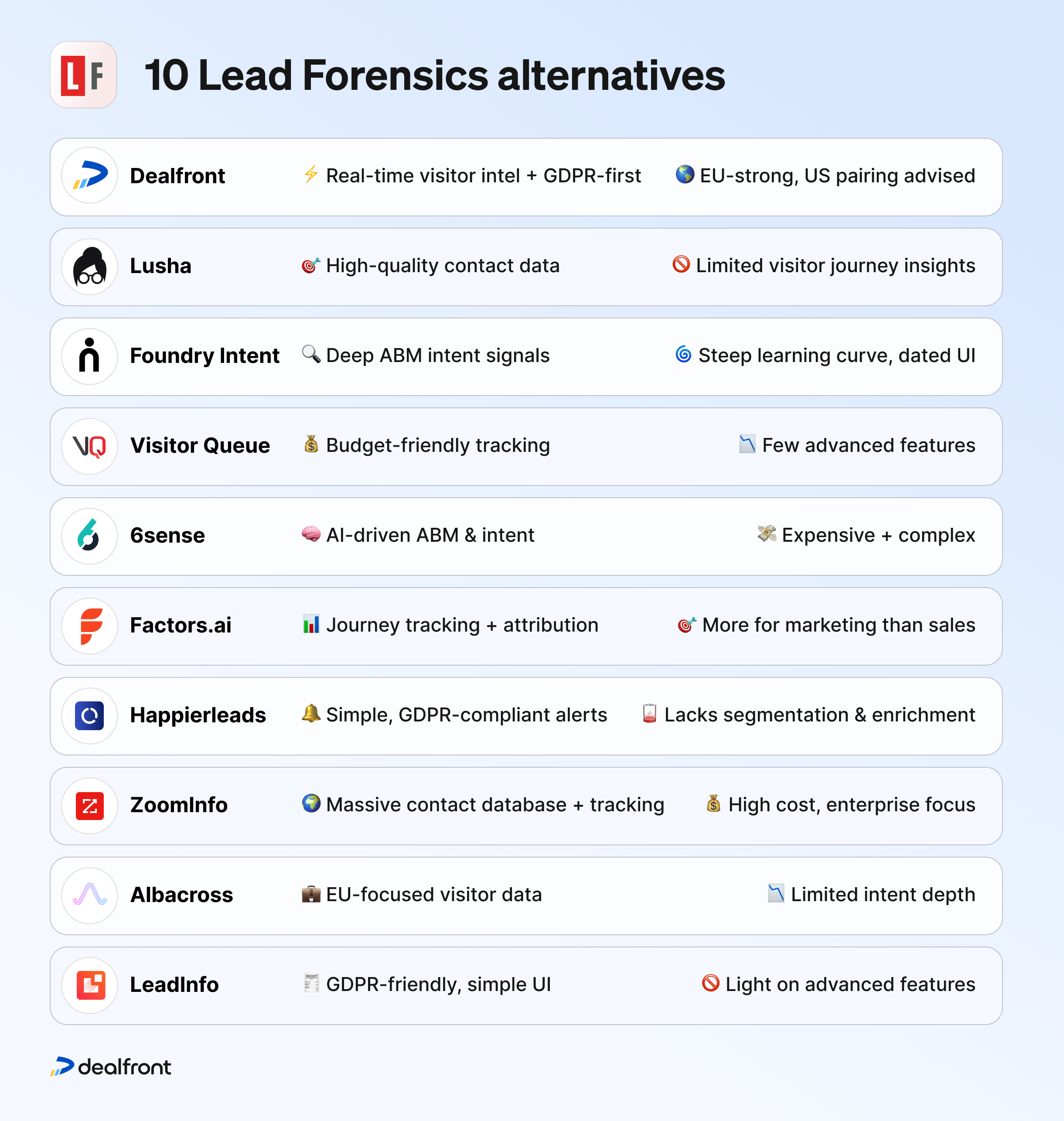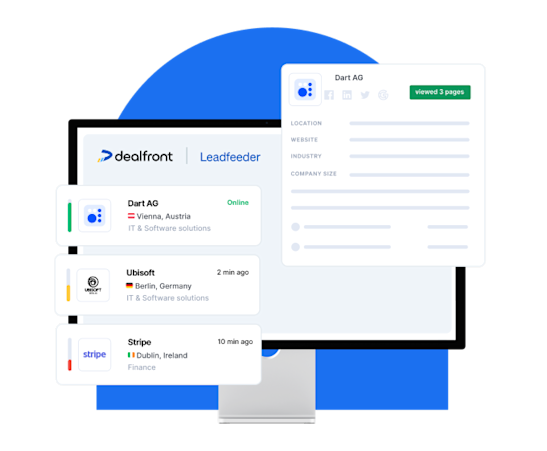60-Second Summary
Identifying anonymous B2B website visitors is key to turning web traffic into leads—but not all tools are created equal. In 2026, many businesses are moving away from legacy platforms like Lead Forensics in favor of more transparent, flexible, and insight-rich alternatives.
Lead Forensics identifies visiting companies using IP data, but lacks depth in intent signals, pricing transparency, and regional coverage—pushing businesses to explore better-suited platforms.
Top alternatives prioritize features like job role-level tracking, CRM integrations, and actionable intent indicators such as repeated visits or pricing page views.
Tools like Dealfront, 6sense, and Foundry Intent stand out by enabling ABM, GDPR compliance, and seamless sales-marketing alignment through real-time alerts and enriched company data.
Choosing the right platform depends on your team size, region, goals, and budget—lean teams prefer intuitive tools like Visitor Queue, while mature organizations benefit from the depth of platforms like 6sense or ZoomInfo.
You're investing time, content, and budget into attracting the right audience… but once they land on your site, what happens? If they're not filling in forms, you’re left in the dark. That’s where website visitor identification tools like Lead Forensics come in.
Lead Forensics is one of the longest-standing players in this space. It's known for identifying anonymous B2B website visitors by matching their IP address to a database of known companies. But while Lead Forensics has its strengths, it’s far from the only solution, and for many businesses in 2026, it may not be the best one either.
Whether you're an ambitious SMB, a scaling marketing team, or just someone who's been burned by "contact us for pricing" conversations one too many times, there are now plenty of alternatives worth exploring.
This article breaks down how Lead Forensics works, its main limitations, and introduces ten strong competitors for you to consider.
What is Lead Forensics?
Lead Forensics is a B2B lead generation tool that identifies companies visiting your website, even if those visitors never fill out a form or download a whitepaper.
It works by using reverse IP lookup technology. When someone visits your site, the platform checks their IP address against a large business database. If there’s a match, you’ll see the company name, industry, location, and sometimes even contact details.
This allows sales and marketing teams to:
See which companies are engaging with website content
Prioritize outreach based on interest level
Generate new leads that otherwise would’ve stayed anonymous
Sales and marketing teams use this information to prioritize which companies to follow up with and to better understand how visitors are interacting with their website content.
Why look for a Lead Forensics alternative?
While Lead Forensics has helped many businesses over the years, it’s not always the right fit, especially for teams that want more transparency, better regional data, or a less “black box” pricing model. Here are a few reasons companies start looking elsewhere:
1. Opaque pricing
You won’t find a pricing page on Lead Forensics’ website. Most businesses are asked to book a demo before even seeing how much it costs. This may work for large enterprises, but many SMBs want clarity upfront, especially when budgets are tight.
2. Lack of intent signals
Lead Forensics tells you who visited your site, but not why. Without additional context, like what stage of the buying journey someone is in, it can be hard to then prioritize leads or personalize any follow-up.
3. Limited coverage in some regions
Lead Forensics is strong in the UK, but coverage outside of core markets (like parts of Europe or North America) can be patchy. If you’re operating in multiple regions, this can lead to gaps in visibility.
4. Data quality and overlap
Some users report frustration with outdated or mismatched company data. You might see multiple “visits” from the same IP that belong to different branches or subsidiaries, leading to confusion and duplication.
5. Not built for modern B2B teams
Many modern sales and marketing teams need tools that integrate easily, offer real-time alerts, support intent scoring, and connect directly to their CRM or marketing automation platforms. Lead Forensics can feel limited in this respect, especially compared to newer, more agile solutions.
What features should you look for when researching Lead Forensics alternatives?
Not all website visitor tracking tools are tackling the problem in the same way. While they might all promise magical insight into who's snooping around your site, the reality is that features, and results, can vary wildly.
So before jumping into demos and free trials, here are the five key capabilities that separate solid Lead Forensics alternatives from tools that’ll just clog up your CRM.
Granular visitor insights (go beyond the company name)
It’s nice to know that someone from a company visited your site. But who exactly? Was it the Head of Procurement or an intern googling your CEO?
The best alternatives to Lead Forensics don’t stop at just company-level identification, they help you drill down into job roles, departments, or buyer personas. Some tools even enrich the visit with known contacts or buying signals, making your follow-up far more relevant and timely.
Integration with sales and marketing tools
Your team shouldn’t have to juggle tabs or copy-paste visitor data into a spreadsheet. Any serious visitor tracking platform should play nicely with the rest of your go-to-market stack.
The best platforms sync seamlessly with:
CRMs like Salesforce and HubSpot
Marketing automation platforms like Marketo and Pardot
Sales enablement tools like Outreach or Salesloft
Even Slack, for real-time alerts when hot prospects are browsing your site
This isn’t just a nice-to-have. It means faster action, less manual work, and better sales-marketing alignment.
Scalable pricing
One of the biggest complaints about tools like Lead Forensics is centred around their vague pricing, long contracts, and the feeling you’re paying more than your neighbor.
Teams, especially startups and mid-sized businesses, need flexibility. Look for pricing that grows with your website traffic or feature needs, not locked-in enterprise plans that make you talk to a salesperson just to get a ballpark.
Dealfront, for example, offers tiered plans and straightforward pricing based on your goals, whether you’re tracking 100 visits a month or 10,000.
Advanced intent signals
Visitor identification is only half the story. What really moves the needle is knowing why someone came to your site, and what that visit says about their buying intent.
Top Lead Forensics alternatives help you identify high-intent behavior like:
Visiting pricing pages
Downloading product information
Returning to your site multiple times
Spending time on high-value pages
Clicking through from targeted campaigns
When your sales team knows who’s ready to talk, they can strike while the lead is hot, without wasting time chasing dead ends.
Compliance and data privacy
If your company operates in (or targets) Europe, privacy isn’t optional. With GDPR, CCPA, and other data regulations tightening every year, your visitor tracking tool needs to do more than just say it’s compliant.
The best platforms:
Are built with privacy-by-design principles
Offer full transparency about data sources
Help you stay compliant with local laws across regions
Give you controls for how data is collected, processed, and stored
This is where platforms like Dealfront shine. As a GDPR-native company with data centers in the EU, it was built from the ground up to respect and protect user privacy, without compromising on insight.
10 Lead Forensics alternatives to consider in 2026
Whether you’re frustrated by clunky interfaces, high costs, or limited data, you’re not alone in looking for a better alternative to Lead Forensics. The good news is there’s a growing field of smarter, more flexible tools that help you identify and act on website visitor intent, often with better UX, pricing transparency, and integrations.
Here are ten of the best Lead Forensics alternatives in 2026:

1. Dealfront
Dealfront (formerly Leadfeeder) is a modern, GDPR-native platform built for B2B revenue teams who want more than just a list of company names. It tells you who is visiting your site, what they’re engaging with, and why it matters, turning anonymous visits into actionable insight.
It stands out with:
Real-time visitor identification enriched with firmographic and behavioral data
Seamless integrations with CRM and marketing tools (like Salesforce, HubSpot, Pipedrive, and Slack)
Advanced filtering and lead scoring so reps can focus on high-intent accounts
A powerful Germany-based data infrastructure, built with privacy by design to meet even the strictest GDPR standards
Over 15,000 companies trust Dealfront to fuel pipeline with genuine buying signals. Whether you're a lean sales team or an enterprise GTM engine, Dealfront offers intuitive workflows, flexible pricing, and localised support that actually speaks your language.
Best for: Teams who want powerful visitor intel, trustworthy and compliant data, and tools that drive real sales action.
2. Lusha
Lusha is primarily recognized for its high-quality contact and lead data, making it a strong tool for sales prospecting and direct outreach. It provides accurate email addresses, phone numbers, and company details, which can boost your outbound efforts by enriching your CRM with actionable contacts.
However, Lusha’s focus is more on contact data than comprehensive visitor identification or intent tracking across web journeys. It doesn’t offer deep anonymous visitor insights or detailed account-level tracking like some dedicated visitor ID platforms. Pricing can also be a consideration, as Lusha charges per contact, which can add up quickly for larger teams.
Drawbacks: Limited visitor journey insights; not a full ABM platform. Lusha performs at its best when paired with other intent or website visitor tools.
3. Foundry Intent (formerly KickFire)
Foundry focuses on surfacing intent signals, especially for ABM (account-based marketing) teams. It combines web tracking with third-party research data to show what target companies are reading across the internet.
That said, its depth of insight can come at the cost of complexity. Users often report a steep learning curve and limited transparency around data freshness. The UI also hasn’t aged especially well.
Drawbacks: Higher barrier to entry; not well-suited for lean teams or fast-moving sales cycles.
4. Visitor Queue
Visitor Queue is a budget-friendly option, great for small businesses or those just getting started with website visitor tracking. It gives you company-level data and basic contact info with minimal setup.
But you get what you pay for. The platform lacks more advanced segmentation, lead scoring, and integrations found in more premium tools. Growing teams may outgrow it quickly.
Drawbacks: Limited feature depth; best for teams with very basic needs.
5. 6sense
6sense is a heavyweight in the intent data space. It uses AI to map buying journeys across channels and surface accounts that are most likely to convert. It's particularly powerful for large B2B teams doing full-scale ABM.
But with great power comes great cost (and complexity). 6sense is overkill for many smaller teams or those just looking for reliable visitor identification. Implementation and training can also be time-intensive.
Drawbacks: Expensive, complex, and more suited for mature sales orgs with dedicated ops resources.
6. Factors
Factors offers a helpful blend of journey tracking and campaign attribution. It shows how anonymous visitors interact with your website and ads, helping marketing teams measure ROI across channels.
Still, its sales enablement features are fairly limited, and some users find its reporting lacks customization. It’s more of a marketing analytics tool than a full-blown visitor ID and intent platform.
Drawbacks: Geared more toward marketers than revenue teams; doesn’t focus on actionable sales insights.
7. Happierleads
Happierleads offers a refreshingly simple take on visitor identification. It shows which companies are checking out your site and sends real-time alerts when target accounts appear.
It’s GDPR-compliant and easy to use, but its simplicity is also its limitation. It lacks the segmentation, enrichment, and filtering needed to prioritize leads effectively at scale.
Drawbacks: Barebones features; lacks depth for more mature sales and marketing workflows.
8. ZoomInfo
ZoomInfo boasts one of the largest B2B contact databases in the world. When paired with its visitor tracking capabilities, it can deliver both company- and individual-level insight for enterprise teams.
However, ZoomInfo comes at a premium price and often requires long contracts. Some users report overly aggressive upselling and a somewhat less-than-stellar customer support.
Drawbacks: Expensive and better suited to enterprise buyers with deep pockets and clear use cases.
9. Albacross
Albacross is another option for companies focused on European markets. It offers decent visitor data and integrates with major CRMs, with pricing that’s approachable for SMBs.
That said, it doesn’t go as deep on intent or contact-level insights as many of its competitors. If your targeting or campaigns are complex, you might find its feature set limiting.
Drawbacks: Limited depth in buyer signals; best for basic European B2B lead gen.
10. LeadInfo
LeadInfo is another GDPR-conscious platform offering simple visitor identification. Its strengths lie in compliance, a slick UI, and basic lead scoring functionality.
But when it comes to broader sales intelligence, intent signals, multi-channel insights, integrations, it's somewhat lightweight. Ideal for smaller European firms with compliance front of mind.
Drawbacks: Lacks advanced sales features; not ideal for larger or international teams.
If you’re serious about finding a better alternative to Lead Forensics in 2026, the field is wide, but uneven. Dealfront offers the most complete mix of usability, insight, compliance, and value.
How to decide the best option for your team
Choosing the right Lead Forensics alternative depends on your specific goals, budget, and how much support your team needs. While some platforms are built for enterprise-scale operations, others are better suited to leaner sales or marketing teams looking for fast insights without complexity.
Start by thinking about your core use case. Are you focused on account-based marketing? Platforms like Dealfront, 6sense, and Foundry Intent offer strong targeting and intent capabilities to help you engage high-value accounts at the right time. For sales teams looking to prospect more effectively, ZoomInfo would also be worth considering thanks to their detailed company and contact-level data. Marketers who want visibility into campaign performance might lean toward Factors, which tracks the entire customer journey. And for smaller businesses or teams just getting started with visitor tracking, tools like Visitor Queue, Happierleads, and Albacross offer simpler, more affordable solutions.
Pricing varies significantly between platforms, so it’s important to choose a tool that fits your current needs and scales with you as you grow:
Budget-friendly (<$100/month): Visitor Queue, Happierleads
Mid-range ($100–$500/month): Dealfront, Lusha, LeadInfo, Albacross
Enterprise ($500+/month): ZoomInfo, 6sense, Foundry Intent
Also, keep in mind how pricing is structured; some charge based on the number of visitors identified, others by user seats or feature access.
Regional data coverage is another important factor, especially if you're focused on a specific market. Not all platforms offer equally strong data in every region:
North America: ZoomInfo, Lusha, and 6sense offer strong US and Canada data
Europe: Dealfront, LeadInfo, and Albacross are especially strong for EU coverage and GDPR compliance
Global needs: Ask vendors directly about their data reach in your target countries or regions, but generally, companies like Dealfront offer a good range of global data while also meeting the compliance requirements of more strictly regulated areas.
Finally, consider onboarding and support processes. Some teams need more guidance than others, especially if resources or time are tight. Platforms like Dealfront, Visitor Queue, and Happierleads are praised for their high-touch support and smooth setup process. If your team is more technical and prefers to self-serve, tools like Factors offer strong APIs and documentation for custom integration.
In the end, it's about fit. If you're looking for a solution that offers strong intent data, native European coverage, deep integrations, and reliable support, Dealfront offers a compelling all-rounder that balances performance with usability and scalability.
Drive better results with a next gen platform
Today, many Lead Forensics alternatives bring a smarter, more flexible approach to B2B sales and marketing. In 2026 platforms go far beyond just telling you which company visited your site, they help you understand who visited, what they’re interested in, and why they might be ready to buy. This depth of insight allows sales teams to start more relevant, better-timed conversations that lead to higher conversion rates.
The best tools also offer seamless integrations with your existing tech stack, from CRMs to marketing automation platforms, ensuring your teams work with up-to-date, connected data without manual effort. And unlike older, rigid contracts, most modern providers offer flexible pricing models, so you can start small, prove value quickly, and scale when you're ready.
Dealfront brings all of these next-gen benefits into one platform. With real-time visitor identification, advanced filters to prioritize high-fit accounts, and easy-to-use workflows, it helps B2B teams convert more web traffic into revenue. Implementation is fast, support is reliable, and the results speak for themselves; that’s why more than 15,000 companies trust Dealfront to power their pipeline.
Ready to see who’s really behind your website traffic? Explore Dealfront's capabilities or try for free and turn anonymous visits into real sales opportunities, without compromising on privacy or data quality.
FAQs about Lead Forensics alternatives
Are Lead Forensics alternatives only focused on B2B companies?
Are Lead Forensics alternatives only focused on B2B companies?
Most Lead Forensics alternatives are designed primarily for B2B companies since they track business IP addresses. Some platforms offer B2C features, but the core technology works best for identifying organizations rather than individual consumers.
What are the best alternatives to Lead Forensics for small businesses?
What are the best alternatives to Lead Forensics for small businesses?
If you're a small business, platforms like Dealfront, Visitor Queue, and Happierleads offer simpler onboarding, affordable pricing, and essential features without overwhelming complexity. These tools are ideal for teams that want value without the enterprise overhead.
Do these tools provide individual-level visitor insights?
Do these tools provide individual-level visitor insights?
Some alternatives can provide individual-level insights when used with proper tracking methods, while Lead Forensics typically only shows company-level data without identifying specific visitors. This is the most complaint approach as laws such as GDPR protect individuals from being personally identified without their explicit consent
How do these platforms handle data privacy regulations?
How do these platforms handle data privacy regulations?
Modern lead forensics alternatives include features for consent management, data minimization, and transparent tracking policies to comply with regulations like GDPR and CCPA, helping businesses maintain legal compliance while still gathering useful visitor data.
Can Lead Forensics alternatives integrate with CRM platforms like HubSpot or Salesforce?
Can Lead Forensics alternatives integrate with CRM platforms like HubSpot or Salesforce?
Yes, many alternatives offer native integrations with major CRMs like Salesforce, HubSpot, and Microsoft Dynamics. Dealfront, for example, allows real-time syncing of visitor data with your sales pipeline, helping teams act faster on qualified leads.
What is the difference between Lead Forensics and Dealfront?
What is the difference between Lead Forensics and Dealfront?
Lead Forensics focuses primarily on company identification through IP tracking, while Dealfront provides additional features like intent data analysis, buying signal detection, and more flexible pricing options with seamless CRM integrations.
Is Lead Forensics worth the cost compared to alternatives?
Is Lead Forensics worth the cost compared to alternatives?
The value depends on your specific needs. Lead Forensics offers reliable company identification but at premium pricing. Alternatives often provide similar core functionality with additional features like individual visitor insights or intent data at more flexible price points.
Is it legal to track website visitors using IP address tools?
Is it legal to track website visitors using IP address tools?
Yes, if done correctly. Modern platforms follow GDPR, CCPA, and other data privacy laws by anonymizing or aggregating data and offering cookie consent tools. Using compliant platforms like Dealfront ensures you stay on the right side of privacy regulations.
Do any Lead Forensics alternatives include intent data?
Do any Lead Forensics alternatives include intent data?
Yes, platforms like Dealfront, 6sense, and Foundry Intent go beyond company tracking to show which accounts are actively researching solutions like yours. Intent data helps prioritize leads that are more likely to convert.
How accurate is the data from Lead Forensics competitors?
How accurate is the data from Lead Forensics competitors?
Data accuracy depends on how the platform collects and enriches visitor information. Tools like Dealfront and ZoomInfo combine IP tracking with firmographic and intent data to improve precision and reduce false positives. It's always best to test coverage in your region or industry.


